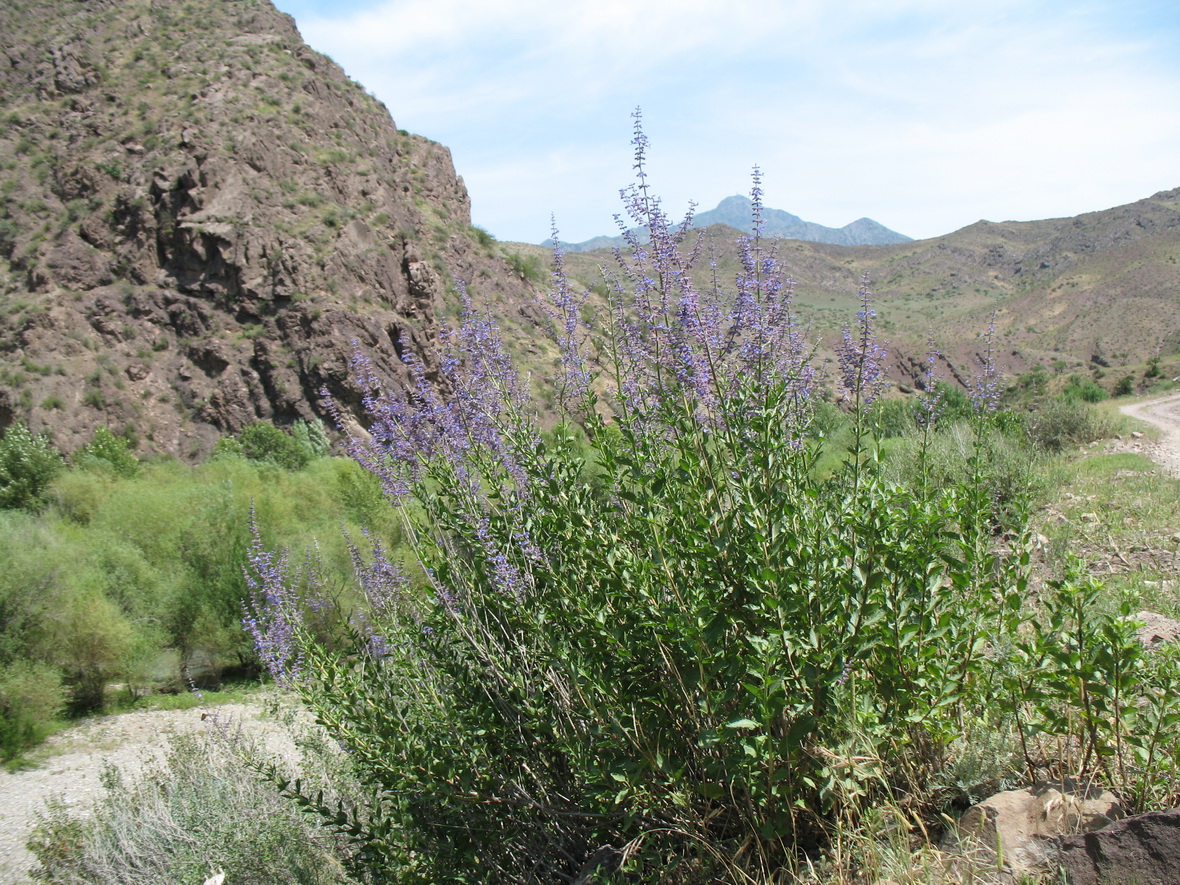COMPONENT COMPOSITION AND ANTIMICROBIAL ACTIVITY OF PEROVSKIA ANGUSTIFOLIA ESSENTIAL OIL
UDC 615.322:547.913+543.544.45
Abstract
The component composition of the essential oil (EO) obtained by hydrodistillation from the air-dry and fresh aboveground parts of the plant Perovskia angustifolia Kudr., growing on the territory of the Namangan region of the Republic of Uzbekistan. By GC-MS, 57 compounds were identified in the composition of the EO from the air-dried plant, while 46 substances were found in the composition of the EO from the fresh plant, which is 94.0 and 96.2% of the total amount of EOs, respectively.
The main EO components of both the air-dry and fresh aerial parts are 1,8-cineole, its content is 24.2 and 25.1%, respectively. EO from an air-dry plant contains camphor (8.6%), endoborneol (7.3%), bornyl acetate (6.2%), caryophyllene (4.4%), α-humulene (4.1%), δ-cadinene (3.8%) and other connections. The dominant components in the composition of EO from a fresh plant, in addition to 1,8-cineol, are camphor (13.8%), endoborneol (8.6%), bornyl acetate (7.0%), γ-terpinene (7.0%), m-cymene (5.2% ), Δ-3-karene (4.5%), δ-cadinene (2.9%). The aerial part of P. angustifolia can serve as a rich source of 1,8-cineole, which is used in bronchitis, colds of the respiratory tract, chronic and inflammatory respiratory diseases.
EO from the aerial part of the air-dry P. angustifolia exhibits a noticeable antimicrobial and antifungal effect against test strains of gram-positive, gram-negative bacteria, while gram-positive bacteria Bacillus subtilis and Staphylococcus aureus turned out to be the most sensitive to the effects of essential oil.
Downloads
Metrics
References
Flora Uzbekistana. [Flora of Uzbekistan]. Tashkent, 1961, vol. 5, pp. 394–396. (in Russ.)
Rastitel'nyye resursy SSSR. Tsvetkovyye rasteniya, ikh khimicheskiy sostav, ispol'zovaniye. Semeystva Hippuridaceae-Lobeliacae. [Plant resources of the USSR. Flowering plants, their chemical composition, use. Families Hippuridaceae-Lobeliacae]. St. Petersburg, 1991, p. 64. (in Russ.)
Shevchuk O.M., Fes'kov S.A. Zemledeliye, 2020, no. 7, pp. 20–24. DOI: 10.24411/0044-3913-2020-10704. (in Russ.)
Mohammadhosseini M., Venditti A., Akbarzadeh A. Toxin Reviews, 2021, vol. 40(4), pp. 484–505. DOI: 10.1080/15569543.2019.1691013.
Kakhky A.M., Rustaiyan A., Masoudi Sh., Tabatabaei-Anaraki M., Salehi H. J. Essent Oil Bear Pl., 2009, vol. 12(2), pр. 205–212. DOI: 10.1080/0972060X.2009.10643712.
Ghaderi Sh., Ebrahimi S.N., Ahadi H., Moghadam S.E., Mirjalili M.H. Biocatal. Agric. Biotechnol., 2019, vol. 19, article 101113. DOI:10.1016/J.BCAB.2019.101113.
Ghoran S.H., Azadi В., Hussain H. Nat. Prod. Res., 2016, vol. 30(17), pр. 1997–2001. DOI: 10.1080/14786419.2015.1101694.
Nuriddinov Kh.R., Khodzimatov K.Kh., Aripov Kh.N., Ozek T., Demirchakmak B., Basher K.H.C. Chem. Nat. Compd., 1997, vol. 33, pp. 299–300. DOI: 10.1007/BF02234879.
Tanaka N., Takahashi S., Kajihara S., Tsuji D., Itoh K., Mamadalieva N.Z., Kashiwada Y. Fitoterapia, 2021, vol. 149, article 104826. DOI: 10.1016/j.fitote.2021.104826.
Tarawneh A., León F., Pettaway S., Elokely K.M., Klein M.L., Lambert J., Mansoor A., Cutler S.J. J. Nat. Prod., 2015, vol. 78(6), pp. 1461–1465. DOI: 10.1021/acs.jnatprod.5b00218.
Perveen S., Malik A., Noor A.T., Tareen R.B. J. Asian Nat. Prod. Res., 2008, vol. 10(11–12), pp. 1105–1108. DOI: 10.1080/10286020802361214.
Farimani M.M., Danton O., Ramseyer J., Kaiser M., Ebrahimi S.N., Salehi P., Batooli H., Potterat O., Hamburger M. Planta Мed., 2018, vol. 84(12-13), pp. 913–919. DOI: 10.1055/a-0608-4946.
Beikmohammadi M. Middle-East J. Sci. Res., 2012, vol. 11, pp. 189–193.
Perveen S., Al-Taweel A.M., Fawzy G.A., Ibrahim T.A., Malik A., Khan A. Asian J. Chem., 2014, vol. 26 (18), pp. 6163–6166. DOI: 10.14233/ajchem.2014.17001.
Ghafourian M., Mazandarani M. Int. J. Womens Health Reprod. Sci., 2016, vol. 5(4), pp. 295–300. DOI: 10.15296/IJWHR.2017.50.
Basher K.H.C., Ozek T., Demirchakmak B., Abduganiev B.Yo., Nuriddinov Kh.R., Aripov Kh.N., Doriev A.S., Kara-taeva Ch.Sh. Chem. Nat. Compd., 1997, vol. 33, p. 296.
Adams R.P. Identification of Essential Oil Components by Gas Chromatography/Mass Spectrometry, ed. 4.1. Allured Publishing Corporation, Carol Stream, Illinois, 2017, 804 p.
Babushok V.I., Linstrom P.J., Zenkevich I.G.J. Phus. Chem. Ref. Data, 2011, vol. 40, no. 4, article 043101. DOI: 10.1063/1.3653552.
Performance Standards for Antimicrobial Susceptibility Testing. CLSI document M100. 28th Edition. Wayne, PA: Clin-ical and Laboratory Standards Institute (CLSI), 2018, 296 p.
Cai Z.M., Peng J.Q., Chen Y., Tao L., Zhang Y.Y., Fu L.Y., Long Q.D., Shen X.C. Asian Nat. Prod. Res., 2021, vol. 23(10), pp. 938–954. DOI: 10.1080/10286020.2020.1839432.
Lahlou S., Figueiredo A.F., Magalhães P.J., Leal-Cardoso J.H. Can. J. Physiol. Pharmacol., 2002, vol. 80(12), pp. 1125–1131. DOI: 10.1139/y02-142.
Sebei Kh., Sakouhi F., Herch W., Khouja M. L., Boukhchina S. Biol. Res., 2015, vol. 48 (1), p. 7. DOI: 10.1186/0717-6287-48-7.
Asanova Zh.K., Suleymenov Ye.M., Atazhanova G.A., Dembitskiy A.D, Pak R.N., Dar A., Adekenov S.M. Khimiko-farmatsevticheskiy zhurnal, 2003, vol. 37, no. 1, pp. 30–32. DOI: 10.30906/0023-1134-2003-37-1-30-32. (in Russ.)
Juergens U.R. Drug Res., 2014, vol. 64(12), pp. 638–646. DOI: 10.1055/s-0034-1372609.

Copyright (c) 2023 chemistry of plant raw material

This work is licensed under a Creative Commons Attribution 4.0 International License.

This work is licensed under a Creative Commons Attribution 4.0 International License.
The authors, which are published in this journal, agree to the following conditions:
1. Authors retain the copyright to the work and transfer to the journal the right of the first publication along with the work, at the same time licensing it under the terms of the Creative Commons Attribution License, which allows others to distribute this work with the obligatory indication of the authorship of this work and a link to the original publication in this journal .
2. The authors retain the right to enter into separate, additional contractual agreements for the non-exclusive distribution of the version of the work published by this journal (for example, to place it in the university depository or to publish it in a book), with reference to the original publication in this journal.
3. Authors are allowed to post their work on the Internet (for example, in a university repository or on their personal website) before and during the review process of this journal, as this may lead to a productive discussion, as well as more links to this published work.











